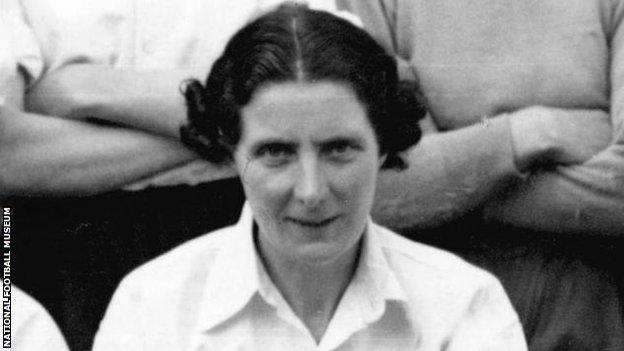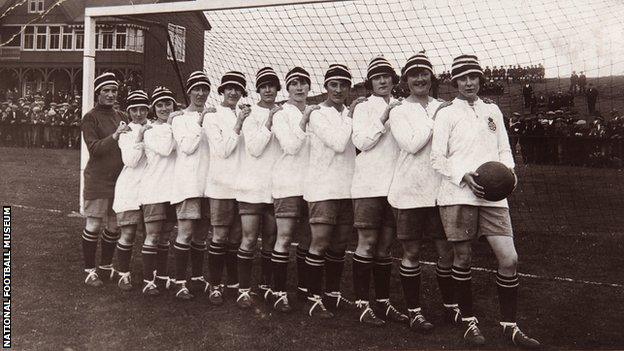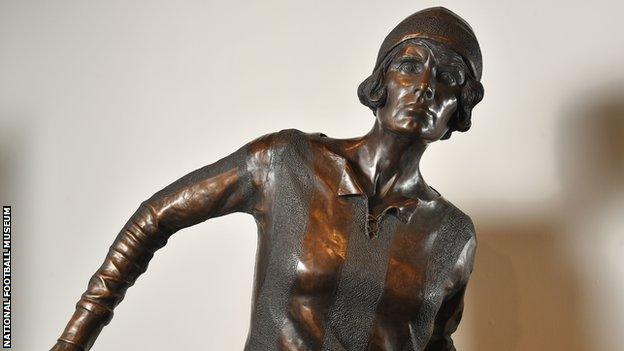Lily Parr - trailblazer with a 'kick like a mule'
- Published
LGBT+ History Month: Goalscoring trailblazer Lily Parr played in front of thousands
"The game of football is quite unsuitable for females and ought not to be encouraged."
These were the words of the Football Association in 1921 as they banned female footballers from playing on professional pitches, leaving them with essentially nowhere to play.
Lily Parr was one of the many women who were potentially denied a professional career by the FA's ruling. But she and her fellow players persevered, playing where they could, and their efforts formed the backbone that the women's game is built on today.
Parr was also unashamedly herself. She and her partner, Mary, were open about their relationship, at a time when members of the LGBT+ community were ostracised.
This is Parr's story - a trailblazer with a left foot like a mule who drew 50,000 capacity crowds.
-----

Lily Parr scored nearly 1,000 goals in a stellar career
Parr was the fourth of seven children, born in 1905 in a deprived area of St Helens. She played football and rugby with her brothers, eventually turning out for the St Helens Ladies football team.
Author Barbara Jacobs said the left-footer had "a natural ability, magic, but honed by her refusal to conform to the art of being a woman. She wasn't having any of it." Parr could kick a ball, and kick it hard; one future team-mate would describe her as having a "kick like a mule".
As men left to fight in World War One, Britain's munitions factories were short-staffed. They turned to women to fill the spaces left, albeit on half the pay of their male counterparts. During lunch breaks, women did what the men did before them - they kicked a football around. The supervisors were initially suspicious before they realised this could be a way to boost productivity, and teams were formed.
In 1919, the Dick, Kerr Ladies team, representing a factory in Preston, met the St Helens Ladies team. They lost 6-1, external, but it was St Helens' 5ft 10in 14-year-old winger who caught the eye of the opposition manager Arnold Frankland. He offered Parr and her team-mate Alice Woods a space on the team and a job in the factory. Frankland reportedly agreed to pay Parr 10 shillings every time she played for the team - and a supplementary payment of a packet of Woodbine cigarettes.
In her first season, Parr scored 43 goals before she turned 16. A local newspaper said there was "probably no greater football prodigy in the whole country." She reportedly broke a male goalkeeper's arm as he tried to block one of her shots.
The most astonishing moment came on 26 December, 1920. More than 53,000 people were inside Everton's Goodison Park stadium to watch Dick, Kerr Ladies, with around 12,000 stuck outside, unable to get in. They beat Parr's former team, St Helens Ladies, 4-0.
The team played 67 matches in 1921, with the players holding down full-time jobs. They twice represented England in matches against Wales - both of which they won - and they also beat Scotland.

Lily Parr (front, holding the football) was the star player for the Dick, Kerr Ladies team
However, the Football Association - the sport's governing body - were also watching. Dick, Kerr Ladies often played matches to raise money for local workers, particularly for out-of-work miners, who the working class players felt a strong connection to.
The FA ruled in 1921 that women could no longer play at major venues, which meant they could not raise money for charity and would have to play on recreational grounds instead. FA members were also barred from officiating any women's football match.
Women's football had been tolerated during the war because it raised morale. But they had not expected its post-war popularity, one which was genuinely threatening the men's game. On 5 December, they declared football was "unsuitable for females".
Parr's dreams of a professional career were ended at the age of 16.
However, the team continued. Frankland took them on a tour of the Unites States of America, where they played nine men's teams in front of crowds of 10,000. In one trip, Parr and three of her team-mates took on the United States' women's Olympic relay team for a race over a quarter of a mile. They won.
The team was renamed Preston Ladies in 1926 and Parr remained with them. By the time she was named captain in 1946, it was reported she had scored 967 of the team's 3,022 goals, and had missed just five matches. During this time, she had qualified and continued to work as a nurse, as well as becoming the first in her family to own her own home. She and Mary worked at the same hospital and were open about their relationship.
Unlike male homosexuality, lesbianism was never illegal in England. Legislation was rejected because of a fear that any attention would encourage women to explore homosexuality., external
Parr played her last game in August 1950, aged 45. She scored one last time in a 11-1 thrashing of Scotland. She scored just under 1,000 goals in her long career, but she had been robbed of a professional one.
Parr died of cancer in 1978, aged 73. She lived to see the FA overturn their decision to ban women playing on associate grounds - in 1970, almost 50 years after it had been imposed - and the governing body would, in 2008, issue an apology for its treatment of women's footballers in Parr's time.

Lily Parr was the first female footballer to be commemorated with a statue
Parr's legacy, as a footballer and an LGBT+ icon, has grown since her death. The Lily Parr Exhibition Trophy was played between LGBT+ football teams from England, France and the United States between 2007 and 2009.
She was the first woman inducted into the English Football Hall of Fame at the National Football Museum in 2002 in Manchester, where a statue was built of her in 2019 to commemorate her achievements. The museum will also be opening a gallery dedicated to her in spring this year.
What Parr achieved was remarkable, and yet, it could have been more. How many people missed out on seeing Parr and her team-mates play? How many female footballers were lost because of the FA's ruling? And how many girls and boys would have been inspired to take up the game if they had been able to see players of Parr's quality on the biggest stages?
But Parr's legacy lives on. It is there every time a female footballer breaks a record, or an event is sold out, or a player is celebrated for her footballing prowess. The success of the women's game is a testament to Parr and those she played alongside.
This piece was originally published as part of the BBC's LGBT+ History Month series in February 2021.